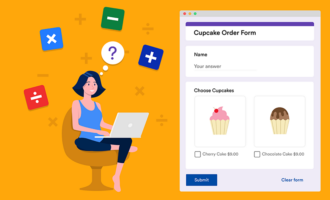Accessing Google Forms Responses
- Find your Google Form in Google Drive.
- Open the form.
- Click on Responses tab.
- Scroll down to see the summary analysis.
- Navigate to the Question tab below Responses.
- Navigate to the Individual tab.
Interactive step-by-step tutorial
Google Forms is a simple and effective form builder that lets users create surveys, questionnaires, signup forms, applications, payment forms, and virtually any type of portal to gather information.
As respondents fill out Google Forms, their submissions are automatically collected in a Google Sheet, making the data accessible and easy to organize. But what if you need help analyzing those responses?
Google Forms analytics makes it easy to visualize response data and glean insights from form respondents. You can also connect your Google Forms to Google Analytics to automate tracking of metrics like response rates, completion times, drop-off points, and most commonly selected options, making it easy to optimize forms for a better user experience and higher conversion rates.
So how do you set up Google Forms analytics? Here’s what you need to know.

Looking for the best alternative to Google Forms?
Jotform’s full-featured form-building solution is mobile-friendly and has the most integrations in the industry. Use it to collect payments, automate workflows, gather leads, and more.
How to access Google Forms responses
Google Forms analytics makes it easy to review your form responses. Here’s how to access the data:
- Open the form you want to view.
Find your form in Google Drive and open it, or create a new form.
- Open your form’s responses.
Click on Responses above the form to go to the form’s analytics. Then scroll down to see the summary analysis that displays data in easy-to-read charts.
- View data on individual questions or respondents.
Go to the Question tab below Responses to see response data for each individual question. You can also go to the Individual tab to see response data for each individual respondent.
Google Forms allows you to review form responses in any format you need, but what if you need detailed analytics on who is engaging with your forms and how? Read on to learn how you can view analytics in Google Forms.
How to get Google Forms responses in Google Analytics
Google Analytics is a versatile platform that allows website owners to track and measure their site’s performance in terms of web traffic and engagement metrics. While there’s no way to directly link your Google Forms to Google Analytics, you can embed your form as an iFrame on a web page and then gather page-level performance data with Google Analytics.
Here’s how to set up a Google Analytics account to do that:
- Open Google Analytics and name your account.
Go to analytics.google.com. Click the Start measuring button.
- Once the setup menu opens, type a name for your account in the text box. Then scroll to the bottom of the page and click Next to move on.
- Follow the rest of the prompts as they appear on the screen.
Here, you can customize Property creation, Business details, Business objectives, and Data collection.
- Connect your website to Google Analytics.
In the Property Settings dropdown menu on your Google Analytics dashboard, select Data collection and modification. This will open another dropdown menu.
Select Data streams under that, then click the Web option to choose a website as your platform. Paste your website link into the Website URL textbox to name your stream. Click the Create stream button. You’ll go to a completion page informing you that it will take up to 48 hours to begin collecting data.
Once you complete this last step, your Google Analytics account will be ready to start tracking traffic and engagement. That means you can embed your Google Form as an iFrame into one of your web pages and connect Google Analytics to it to begin tracking.
Why Jotform is the leading alternative to Google Forms analytics
Want to use Google Analytics to track data directly from your form? Try a Google Forms alternative like Jotform.
Jotform is a highly secure, user-friendly online form builder with over 25 million users. The platform offers more than 10,000 fully customizable templates to kick-start form creation.
Jotform’s forms also seamlessly integrate with the Google product suite, ensuring a smooth transition with minimal disruption to your existing workflow. With top-notch security measures and mobile-friendly features, Jotform is a comprehensive solution for collecting data efficiently.
How to use Jotform analytics
Viewing form responses in Jotform is easy. Here’s how to do it:
- Open your form or create a new one.
Go to My Forms in Jotform, and select the form you want to review submissions for. You can also click the Create Form button in the top left to make a new form.
- View form data in a table.
Click the Submissions link below the form title. This will open a table that lists every form submission, with a column for each field of your form.
- Use Jotform Report Builder to visualize your data.
In your form’s table, click the New Tab button, then the Reports icon. Once you click Next, select the form you want to create a report for from the menu. Click Next again.
Choose the report style you want (Blank, Extended, or Compact) from the next menu and click Next. This will generate a slide deck with the data automatically populated. Edit the slides and data visualizations according to your needs.
Using analytics with Jotform is easy, and thanks to a Google Analytics integration, tracking form analytics with Jotform is simple too.
How to track Jotform submissions with Google Analytics
With Jotform, it’s easy to implement robust tracking of your form’s performance data with Google Analytics:
- Follow the steps in this guide to set up your Google Analytics account, Google Tag Manager (GTM), and triggers.
Once you’ve done that, you’ll need to embed your Jotform form as well as GTM on your website.
- Find and copy your embed source code.
In the Jotform Form Builder, open your form and click on the Publish tab. Click on the Embed option in the left menu, then select Copy Code.
- Connect your GTM account with your website.
Open your website editor and embed the code on the page you want to track. Next, return to your GTM account and click the container you’d like to install on your website. Copy the container code, then add the code to your website’s head and body tags as prompted. Click the Save button to save your new configurations.
Google Forms makes it easy to visualize response data from your forms and make better, more informed decisions. Leveraging Google Analytics also provides insight into your forms’ performance metrics — but pairing the two products isn’t as simple as it appears. Jotform is a great alternative solution.
For an easier, more versatile form analytics experience, Jotform’s Report Builder gives you the tools to create highly customizable data visualizations with the exact aesthetics you want. And since Jotform integrates seamlessly with the Google Analytics platform, you can get the performance metrics to optimize your forms, without the limitations of Google Forms.
Photo by Lukas




















































































































Send Comment: